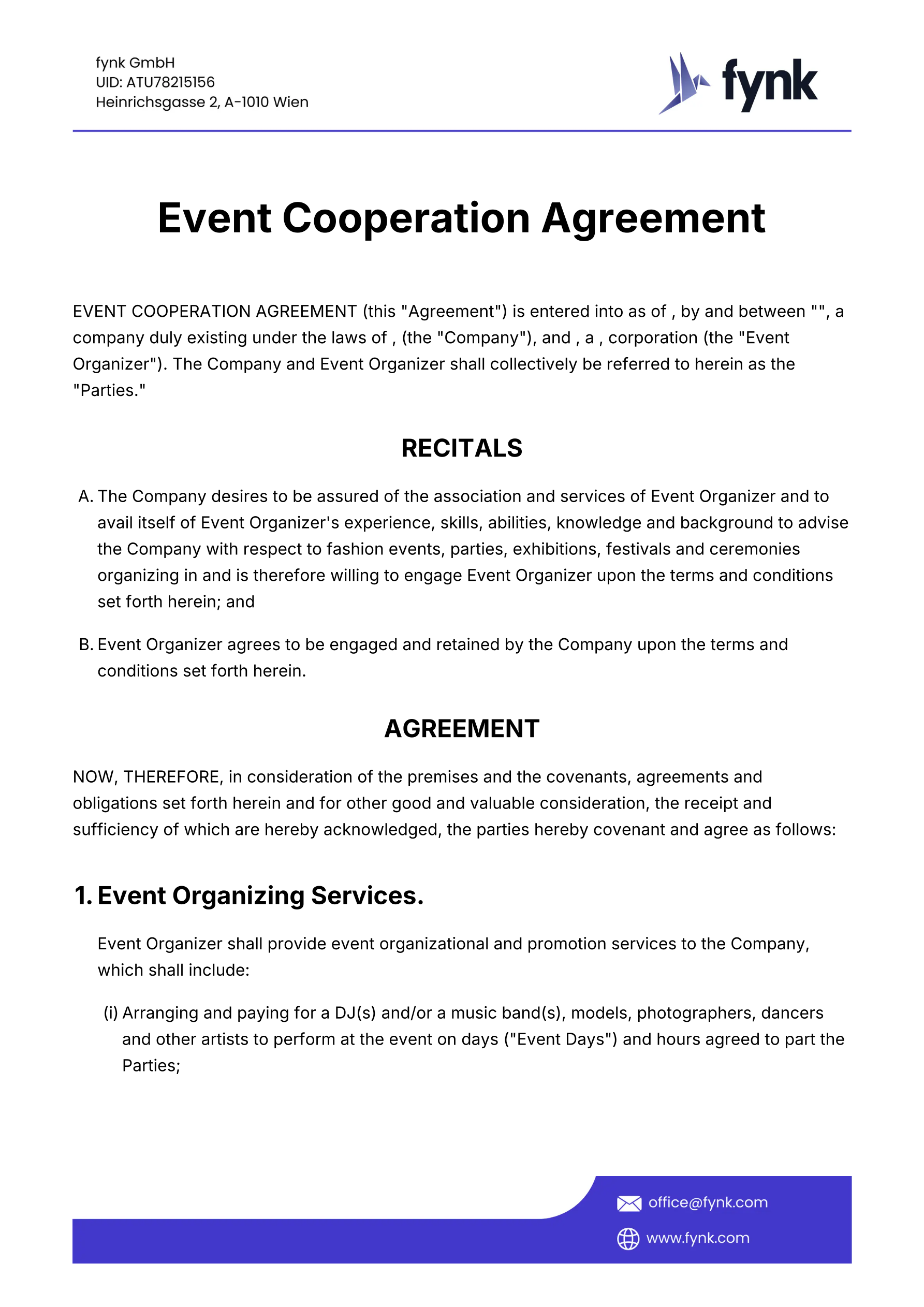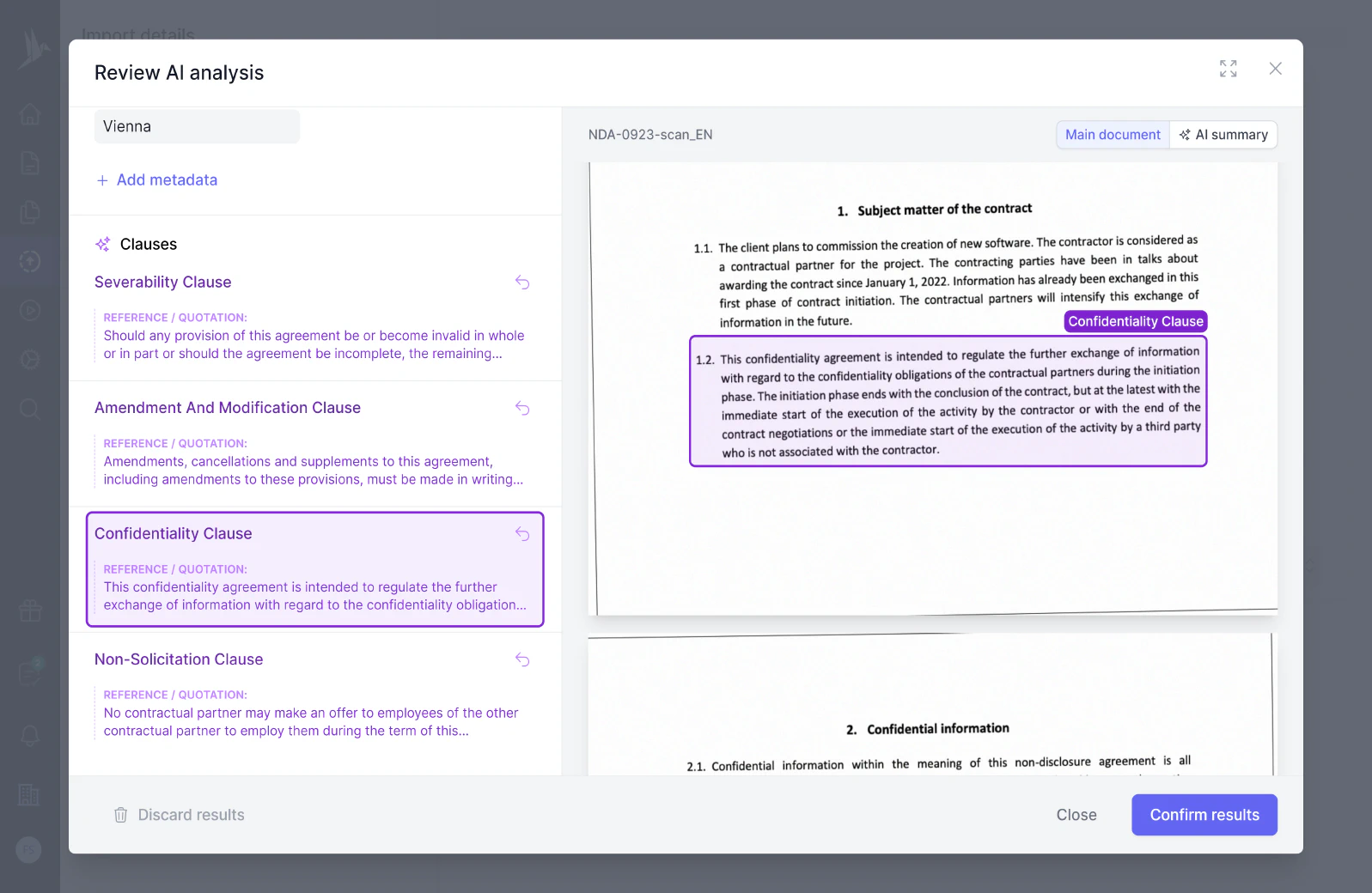
Event Cooperation Agreement Template
Define roles, compensation, and confidentiality between event organizers and companies for professional event execution.
An "Agreement in Principle" clause signifies a preliminary agreement between parties on the fundamental terms and conditions of a future contract, indicating mutual understanding but not yet legally binding. This clause outlines the basic framework and intentions, pending further detailed negotiations and formalization.
As it relates to the matter of the U.S. Department of Justice (“DOJ”), together with federal and state law enforcement agents, executing a search and seizure warrant on the Cumberland facility on May 18, 2022, the Company and DOJ have reached an agreement in principle (the “Agreement in Principle”) to resolve this investigation as to the Company and its subsidiaries, Envigo Global Services Inc. and Envigo RMS, LLC. Any final resolution is subject to certain material contingencies, including, without limitation, negotiations between the Company and DOJ regarding mutually satisfactory resolution documents, final approvals by DOJ and the Company, and depending on the terms of any final resolution with DOJ, negotiations with certain of the Company’s stakeholders regarding the feasibility of such proposed resolution.
While the Company has reached an Agreement in Principle with the DOJ, and believes a resolution is probable and estimable, there can be no assurance that a resolution will be agreed and finalized. Refer to Note 14 – Contingencies for additional information.
For the three and six months ended March 31, 2024, the Company has accrued an estimate of $26.5 million related to the Agreement in Principle. The Company expects to have additional cash outlays in connection with certain costs related to the Agreement in Principle, which would be paid over the next three to five years.
he Goldman Sachs Group, Inc. (NYSE: GS) (Goldman Sachs) today announced that it has reached an agreement in principle with the Government of Malaysia to resolve all the criminal and regulatory proceedings in Malaysia involving the firm, including pending criminal proceedings against subsidiaries of Goldman Sachs and certain of their current and former directors, relating to 1Malaysia Development Berhad (1MDB).
The agreement in principle would involve the payment to the Government of Malaysia of $2.5 billion and a guarantee that the Government of Malaysia receives at least $1.4 billion in proceeds from assets related to 1MDB seized by governmental authorities around the world
The agreement in principle does not resolve the other pending governmental and regulatory investigations involving the firm relating to 1MDB.
n December 2023, we announced that we reached an agreement in principle with the Environmental Protection Agency, the California Air Resources Board, the Environmental and Natural Resources Division of the U.S. Department of Justice and the California Attorney General’s Office to resolve certain regulatory civil claims regarding our emissions certification and compliance process for certain engines primarily used in pick-up truck applications in the U.S (collectively, the Agreement in Principle).
We anticipate making $1.938 billion of the payments required by the Agreement in Principle during 2024 through the use of our existing liquidity and access to debt markets.
This agreement in principle is non-binding and subject to, among other things, satisfactory completion of due diligence by both MDC and Stagwell Media and the negotiation of definitive documentation. Accordingly, there is no assurance that a definitive agreement will be reached, or that the proposed transaction will occur, on the terms and conditions described in this press release or at all.
The Company and the other defendants in the Securities Class Action have denied and continue to deny each and all of the claims alleged in the Securities Class Action, and the entry into the non-binding agreement in principle is not an admission of wrongdoing or acceptance of fault by the Company or any of the other defendants.
The non-binding agreement in principle is subject to numerous terms and conditions including, among other things, (i) the negotiation and execution of a definitive settlement agreement among the parties, (ii) the unilateral right of the Company and the other defendants in the Securities Class Action to terminate the definitive settlement agreement if persons who purchased a number of shares exceeding a to be agreed threshold opt out of and elect not to participate in or be bound by the proposed settlement and (iii) final approval of the definitive settlement agreement by the court. There can be no guarantee that the parties will enter into a definitive settlement agreement (or the final terms thereof), that the Company and the other defendants will not exercise their termination right or that the definitive settlement agreement will receive court approval.
“The European Investment Bank has shown an unwavering commitment to supporting potentially disruptive healthcare innovation in the European Union and this agreement in principle is a testament to their strength as a strategic partner,”
The Agreement in Principle and Settlement shall be null and void and of no force and effect if the terms of the Settlement, except for the Attorneys’ Fees Proposal, does not receive Final Court Approval (as defined below), in which case the Parties shall revert back to their litigation positions prior to entering into the Agreement in Principle and this Stipulation. For the avoidance of doubt, the Settling Parties agree that court approval of the Attorneys’ Fees Proposal is not a condition precedent to the Settlement or Final Court Approval.
The agreement in principle provides material flexibility for us, including aircraft slide rights and substitution rights should we desire to acquire any other 737 MAX model types.
The agreement in principle remains subject to the satisfaction of various conditions, including negotiation and execution of a memorandum of understanding, final stipulation of settlement, notice to the proposed class, and approval by the United States District Court for the Central District of California.
LITTLE ROCK, Ark. – Uniti Group Inc. and its subsidiaries (collectively, “Uniti”) (Nasdaq: UNIT) and Windstream Holdings, Inc. and its subsidiaries (collectively, “Windstream”) jointly announced today that the mediation overseen by the Honorable Shelley C. Chapman has culminated in an agreement in principle (the “Settlement”) to resolve any and all claims and causes of action that have been or may be asserted against Uniti by Windstream, including all litigation brought by Windstream and certain of its creditors in the context of Windstream’s bankruptcy.
Under the terms of the agreement in principle, the Company has agreed to pay a total of $19 million in exchange for a dismissal with prejudice of the Opt-Out Action and mutual releases. As previously disclosed, the Company had accrued $13 million of estimated losses for the Opt-Out Action as of March 31, 2020, which represented the Company’s best estimate of the lower bound of the costs to resolve this case. The proposed settlement contains no admission of liability, wrongdoing, or responsibility by any of the defendants, and is subject to the negotiation and execution of a definitive settlement agreement among the parties.
The entry into the agreement in principle does not affect the class-wide settlement filed with the Court in the Class Action on February 13, 2020.
An Agreement in Principle (AIP), also known as a Memorandum of Understanding (MoU) or a Letter of Intent (LoI), is a document that outlines the preliminary understanding between parties who intend to enter into a contract or a formal agreement. It serves as a “handshake” that spells out the basic terms and conditions that have been agreed upon before the negotiations for a full contract are finalized. Though generally not legally binding, it signifies a commitment to proceed with the detailed development of the arrangement.
You should use an Agreement in Principle when:
Writing an Agreement in Principle involves the following steps:
By understanding the concept, purpose, creation, and common uses of an Agreement in Principle, you’ll be better prepared to navigate the initial stages of contract negotiations effectively.
These templates contain the clause you just read about.

Define roles, compensation, and confidentiality between event organizers and companies for professional event execution.
Dive deeper into the world of clauses and learn more about these other clauses that are used in real contracts.
An agreement not to sue is a legal clause where one party agrees not to pursue any legal action against the other party in relation to specific disputes or claims. This clause can help prevent future litigation by resolving potential conflicts outside the courtroom.
An "Agreement null and void" clause stipulates that the contract or certain provisions within it will have no legal effect if specific conditions or contingencies are not met. This clause serves to protect the parties by voiding the agreement entirely or partially if predetermined circumstances arise, ensuring neither party is bound under such situations.
An AIP (Annual Incentive Plan) bonus clause typically outlines the conditions under which an employee is eligible to receive a performance-based bonus, usually tied to achieving specific individual, departmental, or company-wide goals within a fiscal year. This clause may detail criteria such as performance metrics, payout percentages, timing of disbursement, and any contingencies that could affect bonus eligibility or amounts.
Try our AI contract analysis and extract important clauses and information from existing contracts.
< <
Fill out the form and we will get in touch with you to give you a personal, customized demo of fynk.
Greetings!
I'm Markus, co-founder of fynk. After you've submitted the form, I'll swiftly get in touch with you.
Also, right after you submit your details, you can pick a time that works best for you for our meeting.

